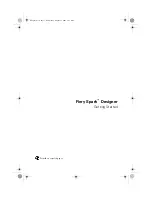
Using UDFs effectively
211
Passing arrays
If you want your function to modify the caller’s copy of the array, the simplest solution is to pass
the array to the function and return the changed array to the caller in the function
return
statement. In the caller, use same variable name in the function argument and return variable.
The following example shows how to directly pass and return arrays. In this example, the
doubleOneDArray
function doubles the value of each element in a one-dimensional array.
<cfscript>
//Initialize some variables
//This creates a simple array.
a=ArrayNew(1);
a[1]=2;
a[2]=22;
//Define the function.
function doubleOneDArray(OneDArray) {
var i = 0;
for ( i = 1; i LE arrayLen(OneDArray); i = i + 1)
{ OneDArray[i] = OneDArray[i] * 2; }
return OneDArray;
}
//Call the function.
a = doubleOneDArray(a);
</cfscript>
<cfdump var="#a#">
This solution is simple, but it is not always optimal:
•
This technique requires ColdFusion to copy the entire array twice, once when you call the
function and once when the function returns. This is inefficient for large arrays and can reduce
performance, particularly if the function is called frequently.
•
You can use the return value of other purposes, such as a status variable.
If you do not use the
return
statement to return the array to the caller, you can pass the array as
an element in a structure and change the array values inside the structure. Then the calling page
can access the changed data by using the structure variable it passed to the UDF.
The following code shows how to rewrite the previous example using an array in a structure. It
returns True as a status indicator to the calling page and uses the structure to pass the array data
back to the calling page.
<cfscript>
//Initialize some variables.
//This creates an simple array as an element in a structure.
arrayStruct=StructNew();
arrayStruct.Array=ArrayNew(1);
arrayStruct.Array[1]=2;
arrayStruct.Array[2]=22;
//Define the function.
function doubleOneDArrayS(OneDArrayStruct) {
var i = 0;
for ( i = 1; i LE arrayLen(OneDArrayStruct.Array); i = i + 1)
{ OneDArrayStruct.Array[i] = OneDArrayStruct.Array[i] * 2; }
return True;
}
//Call the function.
Status = doubleOneDArrayS(arrayStruct);
WriteOutput("Status: " & Status);
</cfscript>
Summary of Contents for COLDFUSION MX 61-DEVELOPING COLDFUSION MX
Page 1: ...Developing ColdFusion MX Applications...
Page 22: ...22 Contents...
Page 38: ......
Page 52: ...52 Chapter 2 Elements of CFML...
Page 162: ......
Page 218: ...218 Chapter 10 Writing and Calling User Defined Functions...
Page 250: ...250 Chapter 11 Building and Using ColdFusion Components...
Page 264: ...264 Chapter 12 Building Custom CFXAPI Tags...
Page 266: ......
Page 314: ...314 Chapter 14 Handling Errors...
Page 344: ...344 Chapter 15 Using Persistent Data and Locking...
Page 349: ...About user security 349...
Page 357: ...Security scenarios 357...
Page 370: ...370 Chapter 16 Securing Applications...
Page 388: ...388 Chapter 17 Developing Globalized Applications...
Page 408: ...408 Chapter 18 Debugging and Troubleshooting Applications...
Page 410: ......
Page 426: ...426 Chapter 19 Introduction to Databases and SQL...
Page 476: ...476 Chapter 22 Using Query of Queries...
Page 534: ...534 Chapter 24 Building a Search Interface...
Page 556: ...556 Chapter 25 Using Verity Search Expressions...
Page 558: ......
Page 582: ...582 Chapter 26 Retrieving and Formatting Data...
Page 668: ......
Page 734: ...734 Chapter 32 Using Web Services...
Page 760: ...760 Chapter 33 Integrating J2EE and Java Elements in CFML Applications...
Page 786: ...786 Chapter 34 Integrating COM and CORBA Objects in CFML Applications...
Page 788: ......
















































